University Business Research: Customer Satisfaction and Loyalty Report
VerifiedAdded on 2021/05/27
|6
|1259
|277
Report
AI Summary
This report analyzes research on customer satisfaction and loyalty, drawing from multiple studies. It examines the relationship between customer satisfaction and loyalty, exploring factors such as service quality in SMEs, marketing strategies, corporate social responsibility (CSR), and the luxury hotel industry. The report highlights common themes, such as the importance of customer relationships, trust, commitment, and delight in generating loyalty. It also contrasts different research methodologies, including quantitative and qualitative approaches, and discusses the limitations of each study. Furthermore, the report outlines future research directions, emphasizing the need for businesses to adapt to changing customer expectations, improve service quality, and strengthen customer relationships to enhance profitability and maintain a competitive edge. The report concludes by summarizing the key findings and implications for business management.
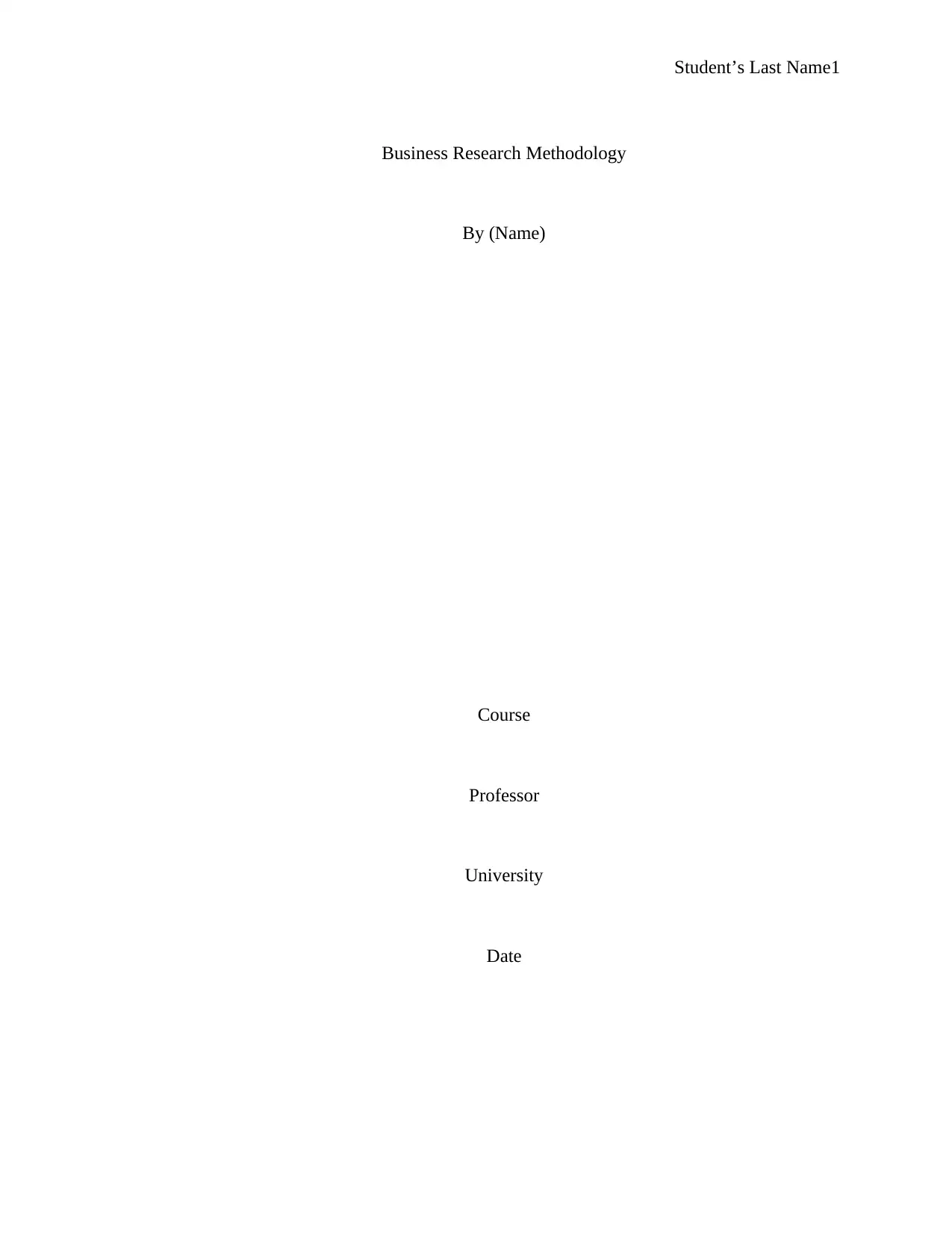
Student’s Last Name1
Business Research Methodology
By (Name)
Course
Professor
University
Date
Business Research Methodology
By (Name)
Course
Professor
University
Date
Paraphrase This Document
Need a fresh take? Get an instant paraphrase of this document with our AI Paraphraser
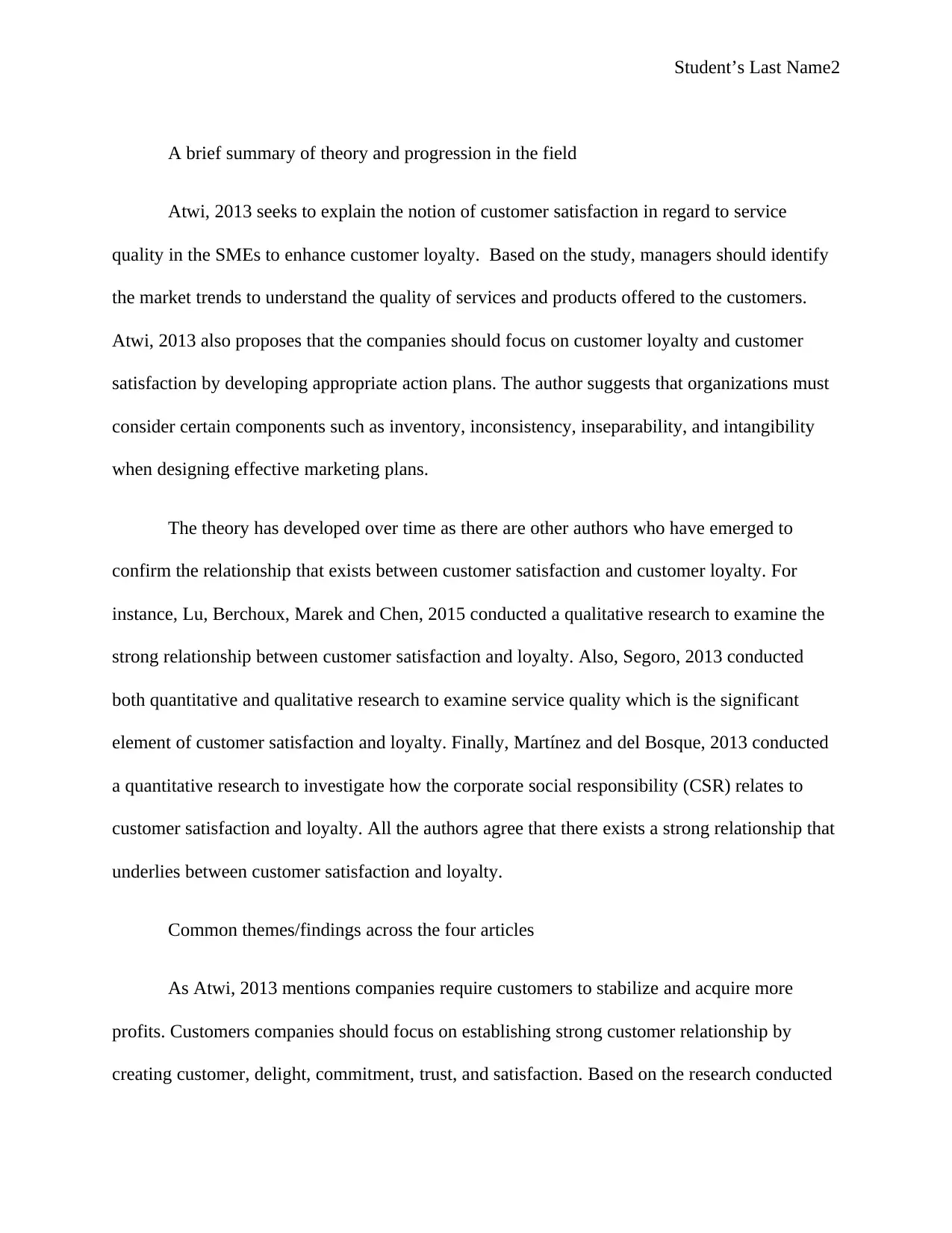
Student’s Last Name2
A brief summary of theory and progression in the field
Atwi, 2013 seeks to explain the notion of customer satisfaction in regard to service
quality in the SMEs to enhance customer loyalty. Based on the study, managers should identify
the market trends to understand the quality of services and products offered to the customers.
Atwi, 2013 also proposes that the companies should focus on customer loyalty and customer
satisfaction by developing appropriate action plans. The author suggests that organizations must
consider certain components such as inventory, inconsistency, inseparability, and intangibility
when designing effective marketing plans.
The theory has developed over time as there are other authors who have emerged to
confirm the relationship that exists between customer satisfaction and customer loyalty. For
instance, Lu, Berchoux, Marek and Chen, 2015 conducted a qualitative research to examine the
strong relationship between customer satisfaction and loyalty. Also, Segoro, 2013 conducted
both quantitative and qualitative research to examine service quality which is the significant
element of customer satisfaction and loyalty. Finally, Martínez and del Bosque, 2013 conducted
a quantitative research to investigate how the corporate social responsibility (CSR) relates to
customer satisfaction and loyalty. All the authors agree that there exists a strong relationship that
underlies between customer satisfaction and loyalty.
Common themes/findings across the four articles
As Atwi, 2013 mentions companies require customers to stabilize and acquire more
profits. Customers companies should focus on establishing strong customer relationship by
creating customer, delight, commitment, trust, and satisfaction. Based on the research conducted
A brief summary of theory and progression in the field
Atwi, 2013 seeks to explain the notion of customer satisfaction in regard to service
quality in the SMEs to enhance customer loyalty. Based on the study, managers should identify
the market trends to understand the quality of services and products offered to the customers.
Atwi, 2013 also proposes that the companies should focus on customer loyalty and customer
satisfaction by developing appropriate action plans. The author suggests that organizations must
consider certain components such as inventory, inconsistency, inseparability, and intangibility
when designing effective marketing plans.
The theory has developed over time as there are other authors who have emerged to
confirm the relationship that exists between customer satisfaction and customer loyalty. For
instance, Lu, Berchoux, Marek and Chen, 2015 conducted a qualitative research to examine the
strong relationship between customer satisfaction and loyalty. Also, Segoro, 2013 conducted
both quantitative and qualitative research to examine service quality which is the significant
element of customer satisfaction and loyalty. Finally, Martínez and del Bosque, 2013 conducted
a quantitative research to investigate how the corporate social responsibility (CSR) relates to
customer satisfaction and loyalty. All the authors agree that there exists a strong relationship that
underlies between customer satisfaction and loyalty.
Common themes/findings across the four articles
As Atwi, 2013 mentions companies require customers to stabilize and acquire more
profits. Customers companies should focus on establishing strong customer relationship by
creating customer, delight, commitment, trust, and satisfaction. Based on the research conducted
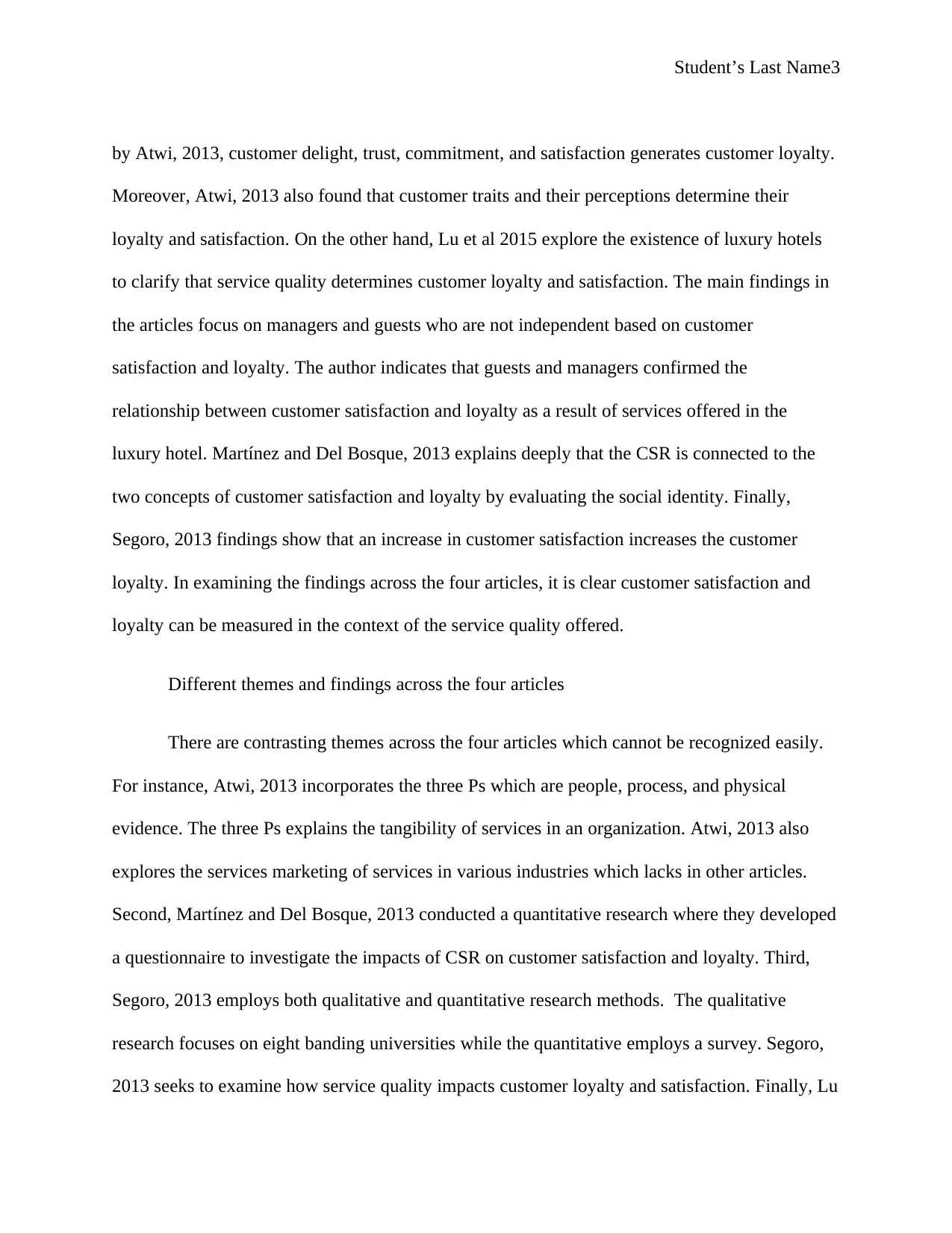
Student’s Last Name3
by Atwi, 2013, customer delight, trust, commitment, and satisfaction generates customer loyalty.
Moreover, Atwi, 2013 also found that customer traits and their perceptions determine their
loyalty and satisfaction. On the other hand, Lu et al 2015 explore the existence of luxury hotels
to clarify that service quality determines customer loyalty and satisfaction. The main findings in
the articles focus on managers and guests who are not independent based on customer
satisfaction and loyalty. The author indicates that guests and managers confirmed the
relationship between customer satisfaction and loyalty as a result of services offered in the
luxury hotel. Martínez and Del Bosque, 2013 explains deeply that the CSR is connected to the
two concepts of customer satisfaction and loyalty by evaluating the social identity. Finally,
Segoro, 2013 findings show that an increase in customer satisfaction increases the customer
loyalty. In examining the findings across the four articles, it is clear customer satisfaction and
loyalty can be measured in the context of the service quality offered.
Different themes and findings across the four articles
There are contrasting themes across the four articles which cannot be recognized easily.
For instance, Atwi, 2013 incorporates the three Ps which are people, process, and physical
evidence. The three Ps explains the tangibility of services in an organization. Atwi, 2013 also
explores the services marketing of services in various industries which lacks in other articles.
Second, Martínez and Del Bosque, 2013 conducted a quantitative research where they developed
a questionnaire to investigate the impacts of CSR on customer satisfaction and loyalty. Third,
Segoro, 2013 employs both qualitative and quantitative research methods. The qualitative
research focuses on eight banding universities while the quantitative employs a survey. Segoro,
2013 seeks to examine how service quality impacts customer loyalty and satisfaction. Finally, Lu
by Atwi, 2013, customer delight, trust, commitment, and satisfaction generates customer loyalty.
Moreover, Atwi, 2013 also found that customer traits and their perceptions determine their
loyalty and satisfaction. On the other hand, Lu et al 2015 explore the existence of luxury hotels
to clarify that service quality determines customer loyalty and satisfaction. The main findings in
the articles focus on managers and guests who are not independent based on customer
satisfaction and loyalty. The author indicates that guests and managers confirmed the
relationship between customer satisfaction and loyalty as a result of services offered in the
luxury hotel. Martínez and Del Bosque, 2013 explains deeply that the CSR is connected to the
two concepts of customer satisfaction and loyalty by evaluating the social identity. Finally,
Segoro, 2013 findings show that an increase in customer satisfaction increases the customer
loyalty. In examining the findings across the four articles, it is clear customer satisfaction and
loyalty can be measured in the context of the service quality offered.
Different themes and findings across the four articles
There are contrasting themes across the four articles which cannot be recognized easily.
For instance, Atwi, 2013 incorporates the three Ps which are people, process, and physical
evidence. The three Ps explains the tangibility of services in an organization. Atwi, 2013 also
explores the services marketing of services in various industries which lacks in other articles.
Second, Martínez and Del Bosque, 2013 conducted a quantitative research where they developed
a questionnaire to investigate the impacts of CSR on customer satisfaction and loyalty. Third,
Segoro, 2013 employs both qualitative and quantitative research methods. The qualitative
research focuses on eight banding universities while the quantitative employs a survey. Segoro,
2013 seeks to examine how service quality impacts customer loyalty and satisfaction. Finally, Lu
⊘ This is a preview!⊘
Do you want full access?
Subscribe today to unlock all pages.

Trusted by 1+ million students worldwide
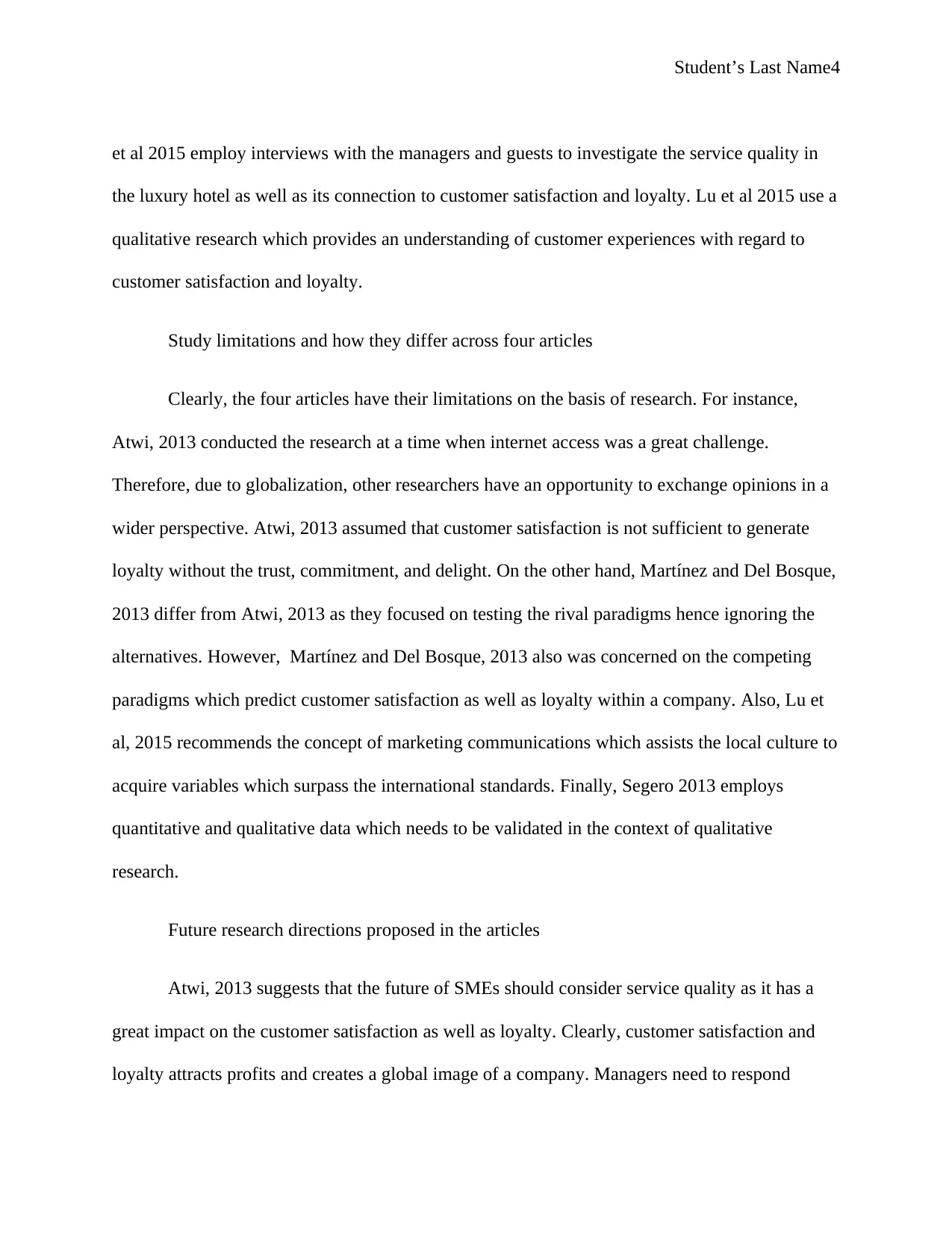
Student’s Last Name4
et al 2015 employ interviews with the managers and guests to investigate the service quality in
the luxury hotel as well as its connection to customer satisfaction and loyalty. Lu et al 2015 use a
qualitative research which provides an understanding of customer experiences with regard to
customer satisfaction and loyalty.
Study limitations and how they differ across four articles
Clearly, the four articles have their limitations on the basis of research. For instance,
Atwi, 2013 conducted the research at a time when internet access was a great challenge.
Therefore, due to globalization, other researchers have an opportunity to exchange opinions in a
wider perspective. Atwi, 2013 assumed that customer satisfaction is not sufficient to generate
loyalty without the trust, commitment, and delight. On the other hand, Martínez and Del Bosque,
2013 differ from Atwi, 2013 as they focused on testing the rival paradigms hence ignoring the
alternatives. However, Martínez and Del Bosque, 2013 also was concerned on the competing
paradigms which predict customer satisfaction as well as loyalty within a company. Also, Lu et
al, 2015 recommends the concept of marketing communications which assists the local culture to
acquire variables which surpass the international standards. Finally, Segero 2013 employs
quantitative and qualitative data which needs to be validated in the context of qualitative
research.
Future research directions proposed in the articles
Atwi, 2013 suggests that the future of SMEs should consider service quality as it has a
great impact on the customer satisfaction as well as loyalty. Clearly, customer satisfaction and
loyalty attracts profits and creates a global image of a company. Managers need to respond
et al 2015 employ interviews with the managers and guests to investigate the service quality in
the luxury hotel as well as its connection to customer satisfaction and loyalty. Lu et al 2015 use a
qualitative research which provides an understanding of customer experiences with regard to
customer satisfaction and loyalty.
Study limitations and how they differ across four articles
Clearly, the four articles have their limitations on the basis of research. For instance,
Atwi, 2013 conducted the research at a time when internet access was a great challenge.
Therefore, due to globalization, other researchers have an opportunity to exchange opinions in a
wider perspective. Atwi, 2013 assumed that customer satisfaction is not sufficient to generate
loyalty without the trust, commitment, and delight. On the other hand, Martínez and Del Bosque,
2013 differ from Atwi, 2013 as they focused on testing the rival paradigms hence ignoring the
alternatives. However, Martínez and Del Bosque, 2013 also was concerned on the competing
paradigms which predict customer satisfaction as well as loyalty within a company. Also, Lu et
al, 2015 recommends the concept of marketing communications which assists the local culture to
acquire variables which surpass the international standards. Finally, Segero 2013 employs
quantitative and qualitative data which needs to be validated in the context of qualitative
research.
Future research directions proposed in the articles
Atwi, 2013 suggests that the future of SMEs should consider service quality as it has a
great impact on the customer satisfaction as well as loyalty. Clearly, customer satisfaction and
loyalty attracts profits and creates a global image of a company. Managers need to respond
Paraphrase This Document
Need a fresh take? Get an instant paraphrase of this document with our AI Paraphraser
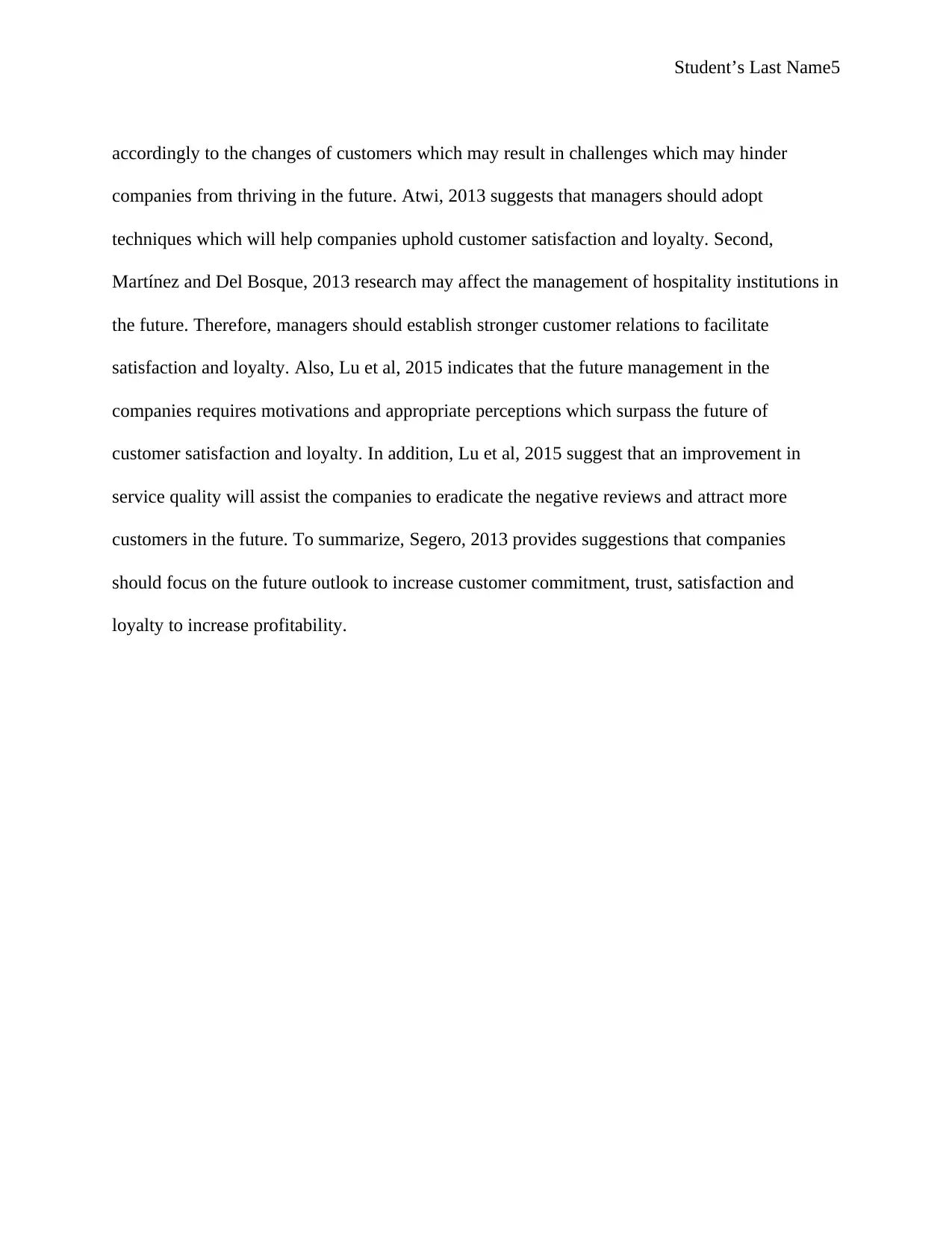
Student’s Last Name5
accordingly to the changes of customers which may result in challenges which may hinder
companies from thriving in the future. Atwi, 2013 suggests that managers should adopt
techniques which will help companies uphold customer satisfaction and loyalty. Second,
Martínez and Del Bosque, 2013 research may affect the management of hospitality institutions in
the future. Therefore, managers should establish stronger customer relations to facilitate
satisfaction and loyalty. Also, Lu et al, 2015 indicates that the future management in the
companies requires motivations and appropriate perceptions which surpass the future of
customer satisfaction and loyalty. In addition, Lu et al, 2015 suggest that an improvement in
service quality will assist the companies to eradicate the negative reviews and attract more
customers in the future. To summarize, Segero, 2013 provides suggestions that companies
should focus on the future outlook to increase customer commitment, trust, satisfaction and
loyalty to increase profitability.
accordingly to the changes of customers which may result in challenges which may hinder
companies from thriving in the future. Atwi, 2013 suggests that managers should adopt
techniques which will help companies uphold customer satisfaction and loyalty. Second,
Martínez and Del Bosque, 2013 research may affect the management of hospitality institutions in
the future. Therefore, managers should establish stronger customer relations to facilitate
satisfaction and loyalty. Also, Lu et al, 2015 indicates that the future management in the
companies requires motivations and appropriate perceptions which surpass the future of
customer satisfaction and loyalty. In addition, Lu et al, 2015 suggest that an improvement in
service quality will assist the companies to eradicate the negative reviews and attract more
customers in the future. To summarize, Segero, 2013 provides suggestions that companies
should focus on the future outlook to increase customer commitment, trust, satisfaction and
loyalty to increase profitability.
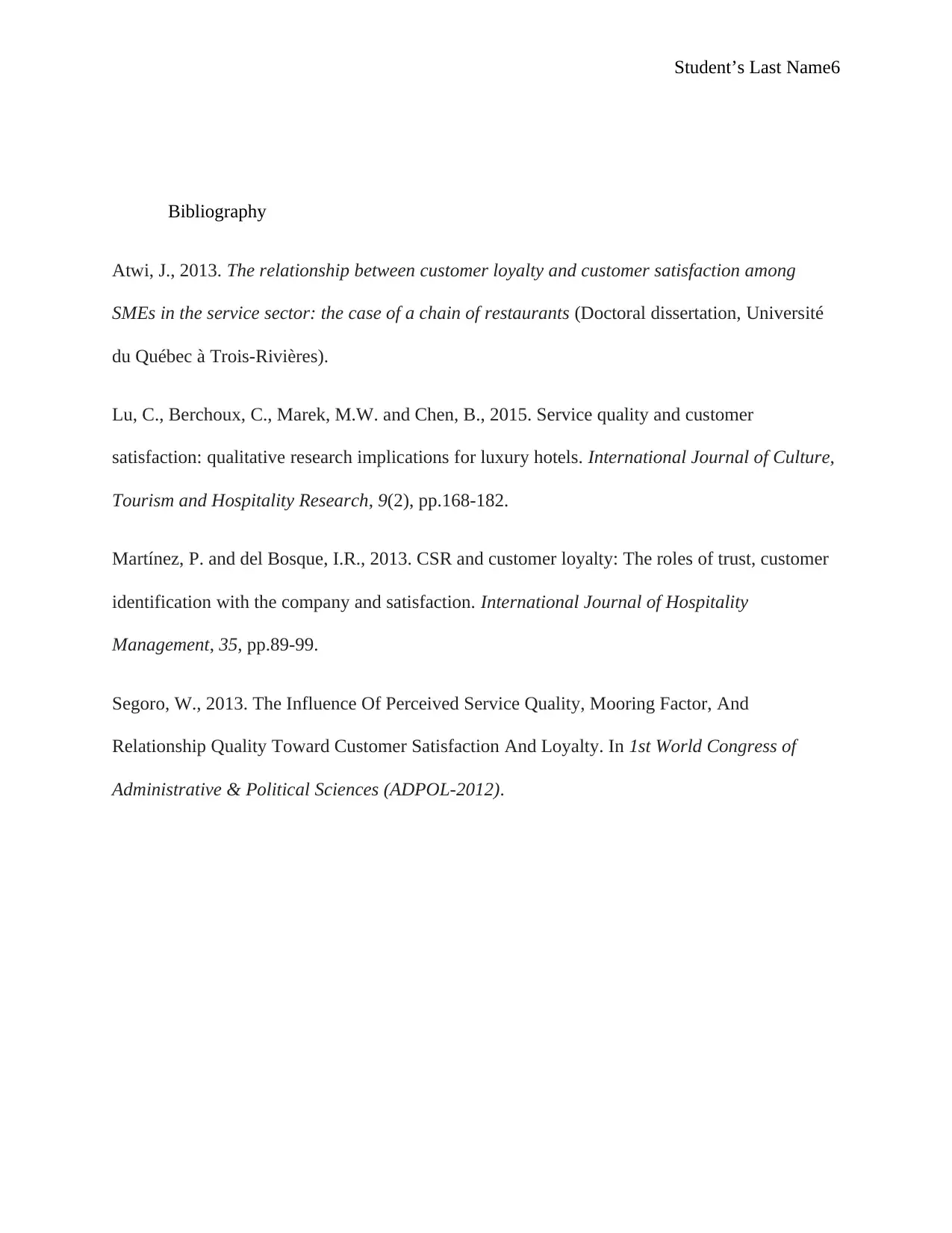
Student’s Last Name6
Bibliography
Atwi, J., 2013. The relationship between customer loyalty and customer satisfaction among
SMEs in the service sector: the case of a chain of restaurants (Doctoral dissertation, Université
du Québec à Trois-Rivières).
Lu, C., Berchoux, C., Marek, M.W. and Chen, B., 2015. Service quality and customer
satisfaction: qualitative research implications for luxury hotels. International Journal of Culture,
Tourism and Hospitality Research, 9(2), pp.168-182.
Martínez, P. and del Bosque, I.R., 2013. CSR and customer loyalty: The roles of trust, customer
identification with the company and satisfaction. International Journal of Hospitality
Management, 35, pp.89-99.
Segoro, W., 2013. The Influence Of Perceived Service Quality, Mooring Factor, And
Relationship Quality Toward Customer Satisfaction And Loyalty. In 1st World Congress of
Administrative & Political Sciences (ADPOL-2012).
Bibliography
Atwi, J., 2013. The relationship between customer loyalty and customer satisfaction among
SMEs in the service sector: the case of a chain of restaurants (Doctoral dissertation, Université
du Québec à Trois-Rivières).
Lu, C., Berchoux, C., Marek, M.W. and Chen, B., 2015. Service quality and customer
satisfaction: qualitative research implications for luxury hotels. International Journal of Culture,
Tourism and Hospitality Research, 9(2), pp.168-182.
Martínez, P. and del Bosque, I.R., 2013. CSR and customer loyalty: The roles of trust, customer
identification with the company and satisfaction. International Journal of Hospitality
Management, 35, pp.89-99.
Segoro, W., 2013. The Influence Of Perceived Service Quality, Mooring Factor, And
Relationship Quality Toward Customer Satisfaction And Loyalty. In 1st World Congress of
Administrative & Political Sciences (ADPOL-2012).
⊘ This is a preview!⊘
Do you want full access?
Subscribe today to unlock all pages.

Trusted by 1+ million students worldwide
1 out of 6
Related Documents
Your All-in-One AI-Powered Toolkit for Academic Success.
+13062052269
info@desklib.com
Available 24*7 on WhatsApp / Email
![[object Object]](/_next/static/media/star-bottom.7253800d.svg)
Unlock your academic potential
Copyright © 2020–2025 A2Z Services. All Rights Reserved. Developed and managed by ZUCOL.





